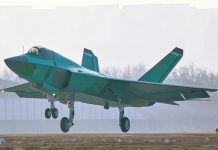Live-fire drills play a major role in military training. The Russian Aerospace Forces seem to have taken things “up by a notch” with a very rare launch of multiple air-to-air missiles from their Flanker multi-role warplanes.
Video footage posted by a Russian social media user shows the Su-30 fighters firing multiple air-to-air missiles. The video was shot from the cockpit of another Flanker series jet, however, it was not specified when or where the footage was recorded.
Russian fighters (look like Su-30SM) launching air-to-air missiles. https://t.co/8IaYS3FwM8 pic.twitter.com/8nZvYNAHbI
— Rob Lee (@RALee85) January 4, 2022
In the video, a formation of four Su-30SM (NATO name Flanker) fighter jets is seen launching a pair of air-to-air missiles. The missiles look like infrared-homing R-73 (AA-11 Archer) or the R-74 series weapons. A similar weapon can also be spotted on the underwing station, as reflected in the pilot’s mirror of the Flanker jet from which the video was taken.
While the caption of the video offers very little details, it does suggest that these missiles were fired at an M-6 target. An M-6 is a device resembling a bomb that is dropped from another aircraft before it descends slowly under the parachute. The M-6 then releases an infrared or radio-frequency-based target that engages these air-to-air missiles or even ground-based or naval air defense systems.
PHOTO: Russian #Airforce Sukhoi Su-35S takes off for the «Ladoga-2021» exercise. Via Spotting Petrozavodsk pic.twitter.com/PtgWkLav3W
— Missilito (@Missilito) March 17, 2021
The video gives the impression that one Su-30S carried four M-6 targets. The footage released online does not provide many crucial details such as the number of targets that the missiles engaged or the distance between the aircraft and the targets and also if the missiles were successful in demonstrating the capability they were being tested for.

The launch of eight air-to-air missiles is certainly a rare and dramatic feat. However, the short distance between the Flankers was an uncommon practice with respect to a normal air combat scenario. One of the Flankers seen in the video was compelled to release its ‘barndoor’ air break in order to maintain the formation throughout the exercise.
This shows that the Russian live-fire drill was tailored to some extent to draw attention from the public, which is a common practice. In 2012, The Aviationist had reported that four of the US Air Force’s F-15s were seen live-firing air-to-air missiles simultaneously.
Live-Fire Drills
Live-fire drills provide a pilot with a real combat experience, which is completely different from the training given by a simulator. With the addition of more jets and missiles, these drills become more and more complex and require skillful cooperation.
Despite their advantages, live-fire exercises sometimes result in ‘blue-on-blue’ incidents. In September 2020, a Russian Aerospace Forces Su-35S shot down one of its own Su-30 with its cannon fire during a close-air-combat training in the Western Military District, The Aviation Geek Club reported at that time.
In another incident, which occurred in 2017 but did not come to light till 2019, a Russian MiG-31 Foxhound interceptor downed its wingman with the help of its R-33 long-range air-to-air missile during an exercise over a training range close to Russia’s border with Mongolia, The National Interest had reported.

The US military usually conducts live-fire exercises before the deployment of any of its fighter squadrons to operational theaters. Most of the time, these squadrons remain prepared for deployment in Syria where the Russian Aerospace Forces also maintain a consistent presence and have also gained great combat experience.
The Ladoga series is believed to be the most popular Russian live-fire training. These exercises are named after the freshwater lake located in the Republic of Karelia and Leningrad Oblast in northwestern Russia. Live-fire drills of such sort are a great way of evaluating a missile’s efficiency and its interface with the aircraft.
Missiles Used
Apart from the R-73, which has been in service with the Russian military, there is also a newer and advanced R-74M, inducted in 2012. While it looks very similar to the R-73, the missile is equipped with a new, two-band infrared seeker, offering a greater range. This minimizes the possibility of an enemy aircraft escaping it in a tight-turning dogfight.
Meanwhile, the R-74M has reportedly developed some snags in its seeker. These seekers were originally provided by a company in Ukraine which ended its cooperation with Russia after it annexed Ukraine’s Crimea region in 2014.
Since then, Russia has been bringing in the K-74M2, which has been optimized for internal carriage on Russia’s new-generation Su-57 Felon fighter jets. There are also reports of Russia developing a completely new Izdeliye 300M missile.
- Written by Kashish Tandon/EurAsian Times Desk
- Contact the author at: kashishtandon21@gmail.com
- Follow EurAsian Times on Google News




